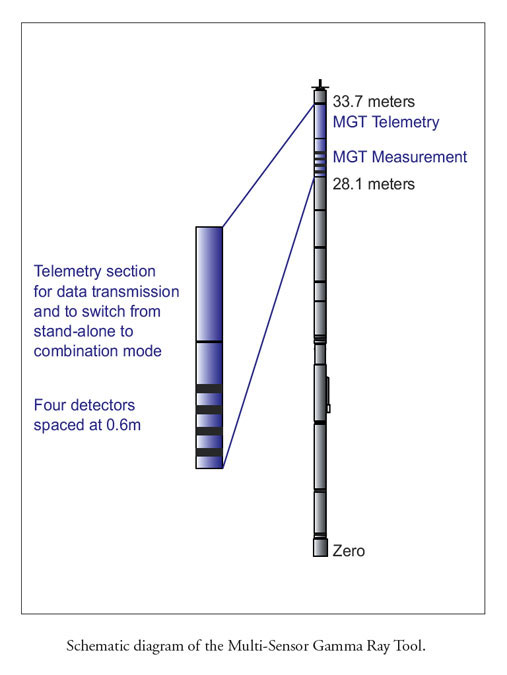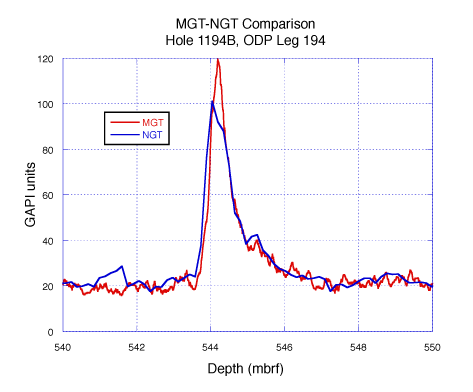Multi-Sensor Spectral Gamma Ray Tool (MGT)
Description
- The Multi-Sensor Spectral Gamma Ray Tool (MGT) is a third party tool developed by the Lamont-Doherty Borehole Research Group to improve the vertical resolution of natural gamma-ray logs. This is achieved by using an array of short detector modules with approximately 2 ft (60 cm) spacing. Each module comprises a small 2″x4″ (5×100 m) NaI detector, a programmable 256-channel amplitude analyzer, and an Am241 calibration source. The spectral data are later recalculated to determine the concentration of potassium, thorium, and uranium radioisotopes or their equivalents. The spectral data from individual modules are sampled 4 times per second and stacked in real time based on the logging speed. This approach increases vertical resolution by a factor of 3-4 over conventional Schlumberger tools while preserving comparable counting efficiency and spectral resolution. The radius of investigation depends on several factors: hole size, mud density, formation bulk density (denser formations display a slightly lower radioactivity) and the energy of the gamma rays (a higher energy gamma ray can reach the detector from deeper in the formation).
The tool also includes an accelerometer channel to improve data stacking by the precise measurement of logging speed. A specialized telemetry system developed for the MGT allows it to be combined with Schlumberger tool strings in a single logging operation, minimizing the required rig time to acquire the log.
Applications
Thin bed analysis. Spectral gamma ray logs provide one of the best means to investigate the mineralogy of thin-bedded sedimentary sequences, Increasing vertical resolution over currently available tools provides new opportunities for log analysis in reservoirs with rapidly changing lithology and for finer resolution of thin layering and in areas with low sedimentation rates. The added resolution provided by the MGT will be of particular use in paleoclimate studies.
Correlation between logging runs
Integration of core and logging data
Paleoclimatology. The added resolution provided by the MGT is particularly useful in paleoclimate studies.
Environmental Effects
The MGT response is affected by borehole size, mud weight, and by the presence of bentonite or KCl in the mud. KCl is sometimes added to the mud to stabilize freshwater clays which tend to swell and form bridges. This procedure takes place before logging operations start, and even though KCl is probably diluted by the time the tool reaches total depth, it can still affect the tool response.
Tool Specifications
| Temperature rating: | 212° F (100° C) |
| Pressure rating: | 10 kpsi (69 MPa) |
| Diameter: | 3.375 in (8.6 cm) |
| Length (telemetry module): | 9 ft (2.7 m) |
| Length (measurement module): | 9.5 ft (2.9 m) |
| Weight: | 350 lbs (151.1 kg) |
| Number of spectrometry modules: | 4 |
| Module spacing: | 25.19 in (64 cm) |
| Detector type: | NaI(TI) |
| Detector size: | 4×2 in (10×5 cm) |
| Maximum cable length : | 40 ft (131.2 m) |
| Maximum logging speed : | 900 ft/hr (275 m/hr) |
| Cable head connection: | Schlumberger style |
| Sample rate: | 4 sec |
Measurement Specifications
| Acceleration | |
| Range (option 1): | ±4 g |
| Range (option 2): | ±25 g |
| Pressure | |
| Range: | 0-10 kpsi (69 MPa) |
| Resolution: | 1 psi (6.9 kPa) |
Major Outputs
| GR: | GAPI |
| POTA: | wt % |
| THOR: | ppm |
Deployment Notes
The MGT is usually run at the top of the Schlumberger string comprising the HRLA, APS, HLDS, and HNGS tools . The downhole switch in the MGT telemetry module provides switching of the signal and power lines between the MGT and the Schlumberger logging system.


